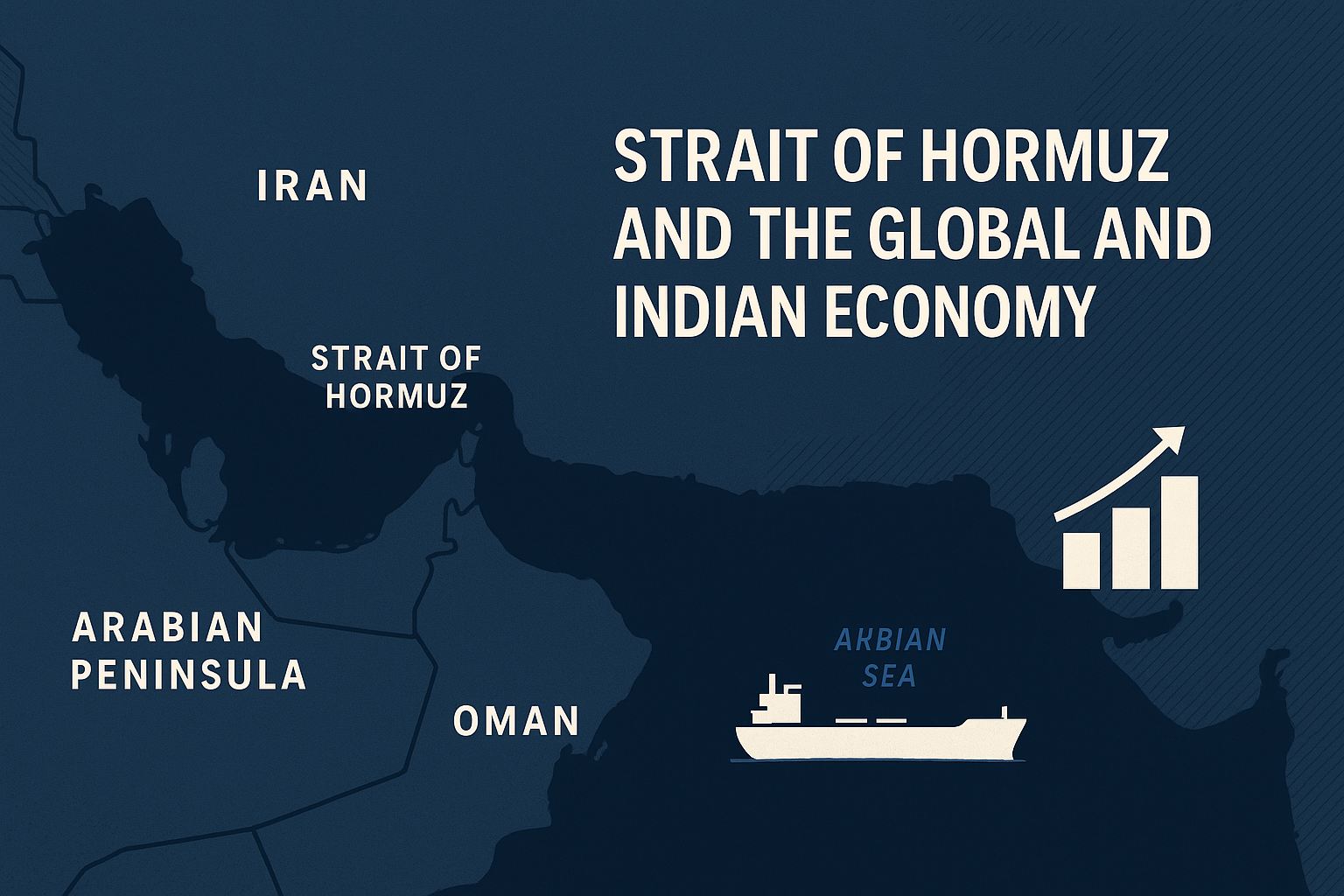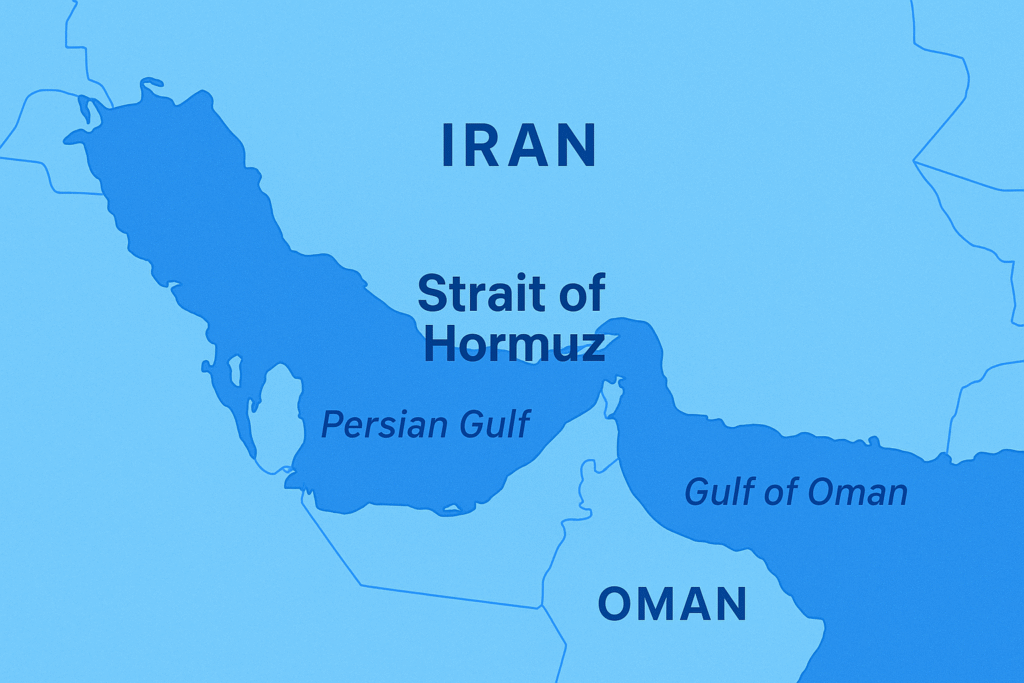
Introduction: The Strait of Hormuz as a Global Economic Lifeline
The Israel-Iran conflict has thrust the Strait of Hormuz, a 54-km-wide maritime passage between Iran and Oman, into the spotlight as a critical chokepoint for global energy markets.The Hormuz Strait map shows its strategic position, influencing crude oil prices globally.
As international news tracks developments, fears grow over the Strait of Hormuz closed scenario. The Iran Hormuz Strait standoff highlights the state of Hormuz region’s geopolitical volatility.
This narrow waterway connects the Persian Gulf to the Gulf of Oman and the Arabian Sea, serving as the primary route for approximately 30% of the world’s seaborne oil trade (around 20 million barrels per day) and 20% of global liquefied natural gas (LNG) exports.
Major oil producers like Saudi Arabia, Iraq, the UAE, Kuwait, Qatar, and Iran rely on this corridor to supply energy to Asia, Europe, and beyond. Any disruption here sends shockwaves through global economies, impacting oil prices, inflation, and trade stability.
Strait of Hormuz Map

Rising Tensions in the Middle East near Iran Hormuz Strait : A 2025 Flashpoint
In June 2025, the Israel-Iran conflict escalated following U.S. airstrikes on three Iranian nuclear facilities—Fordow, Natanz, and Isfahan—prompting Iran’s parliament to approve a potential closure of the Strait of Hormuz.
The final decision rests with Iran’s Supreme National Security Council, but the threat alone has heightened global concerns. Iranian Revolutionary Guard commander Esmail Kowsari emphasized that closing the Strait is “under serious consideration” as a retaliatory measure.
This follows a history of Iran leveraging its strategic control over the Strait during tensions, though it has never fully blocked the passage, even during the Iran-Iraq War.
If Strait of Hormuz closed : Global Energy Market Disruptions
The mere threat of a Strait closure has already driven Brent crude prices to $90 per barrel in June 2025, a 20% surge from earlier levels. Analysts from Citigroup and Goldman Sachs warn that a sustained closure could push oil prices to $120–$150 per barrel, potentially shaving 1–2% off global GDP and fueling global inflation by a similar margin.
In the U.S., gasoline prices could exceed $4 per gallon, straining household budgets. European and Asian economies, heavily reliant on Gulf oil, face similar inflationary pressures, with China, India, Japan, and South Korea importing 5.4, 2.1, 1.7, and 1.6 million barrels per day, respectively, through the Strait in Q1 2025.
Closure Scenario: A Global Supply Shock
A full or partial closure of the Strait would disrupt 30% of global oil supply and 33% of LNG exports, triggering immediate supply shortages. Shipping costs could rise by 300–400% due to rerouting around Africa, with maritime insurance premiums spiking as tanker risks increase.
The International Energy Agency (IEA) warns of “significant consequences” for global energy markets, with OPEC and U.S. strategic reserves potentially insufficient to offset prolonged disruptions. The U.S. Navy’s Fifth Fleet, stationed in Bahrain, and European-led EMASoH maritime patrols would likely respond to secure the Strait, risking military escalation.
Economic Fallout Across Regions
- Energy Price Inflation: A prolonged crisis could drive oil prices to $200–$300 per barrel, exacerbating global inflation by 1–2% on Consumer Price Indices (CPI).
- Stock Market Volatility: Sectors like airlines, freight, and consumer goods would face declines, while energy and defense stocks could see gains.
- Global Trade Disruptions: Rerouting ships via the Cape of Good Hope would add 15–20 days to transit times, increasing costs and delaying critical supply chains.
- Strategic Reserve Releases: The IEA, OPEC, and U.S. may release reserves to stabilize supply, but their capacity is limited compared to the Strait’s daily flow.
India’s Vulnerability to the Israel-Iran Conflict
India, importing 85% of its crude oil and 50% of its LNG, is particularly exposed. Approximately 60–65% of India’s crude oil imports (2–2.5 million barrels per day out of 5.5 million) and 40–50% of its LNG transit through the Strait, primarily from Gulf suppliers like Saudi Arabia, Iraq, the UAE, and Qatar.
A closure would spike domestic fuel prices, increase CPI/WPI inflation by 0.4–0.8% for every $10 rise in crude, and reduce GDP growth by 0.5%. This would widen India’s trade deficit, weaken the rupee, and raise costs for transport, manufacturing, and agriculture.
Impact on India’s Trade and Exports
Beyond energy, a Strait closure would disrupt India’s $12 billion trade with West Asia, particularly affecting basmati rice exports to Iran, which face 20% higher insurance premiums and competition from Pakistan. Freight cost inflation and delays would hit shipping-dependent sectors like textiles, chemicals, and electronics, increasing input costs and squeezing industrial margins. The India-Middle East-Europe Corridor (IMEEC), reliant on ports like Fujairah and Salalah, could also face disruptions, stalling India’s strategic trade ambitions.
India’s Mitigation Strategies
India has taken proactive steps to bolster its energy security:
- Diversified Sourcing: India has increased crude imports from Russia (via Suez, Cape of Good Hope, or Pacific routes), West Africa, the U.S., and Brazil, reducing reliance on Gulf oil. Russian oil, now a major source, bypasses the Strait.
- Strategic Petroleum Reserves: India maintains reserves covering 9–10 days of imports, with plans to expand capacity. The government may also subsidize diesel and LPG prices to curb inflation.
- Maritime Security: Operation Sankalp, launched in 2019, ensures safe passage for Indian vessels through the Strait, supported by naval escorts.
- Alternative Routes: Investments in the Chabahar–Zahedan pipeline aim to bypass the Strait for future trade, though progress remains slow.
Global and Regional Mitigation Efforts
- Infrastructure Bypasses: Saudi Arabia’s East-West pipeline (5 million bpd) and the UAE’s Fujairah pipeline (1.8 million bpd) offer 2.6 million bpd of bypass capacity, though this is insufficient to offset the Strait’s 20 million bpd flow. Iran’s Jask pipeline adds 0.3 million bpd.
- Diplomatic Efforts: The U.S. has urged China to dissuade Iran from closing the Strait, while EMASoH patrols by European navies aim to secure navigation.
- Energy Transition: India and other nations are accelerating green energy initiatives, including solar, wind, and hydrogen projects, to reduce long-term reliance on fossil fuels.
Long-Term Implications and the Path Forward
The Strait of Hormuz remains a volatile flashpoint in the Israel-Iran conflict, with the potential to disrupt global energy markets and economies. For India, the threat underscores the need for energy diversification, enhanced strategic reserves, and robust diplomatic engagement to navigate geopolitical tensions.
Globally, the crisis highlights the urgency of transitioning to renewable energy to mitigate reliance on vulnerable chokepoints. As the world watches Iran’s next move, the interplay of military, economic, and diplomatic factors will shape the future of global trade and energy security.
Read Daily Current Affairs on : Answerias.in/current-affairs
Strait of Hormuz : FAQ
what Strait of Hormuz connects ?
The Strait of Hormuz connects the Persian Gulf to the Gulf of Oman and the Arabian Sea.
Strait of Hormuz between which countries ?
The Strait of Hormuz is between Iran (to the north) and Oman (Musandam exclave, to the south).
what is Strait of Hormuz importance ?
The Strait of Hormuz is important because:
It is one of the world’s busiest oil transit chokepoints.
Around 20% of global oil and a significant amount of liquefied natural gas (LNG) pass through it.
It is vital for the energy security of many countries.
Any disruption can significantly impact global oil prices and trade.
Who controls the Strait of Hormuz?
The Strait of Hormuz is controlled by Iran and Oman, as it lies between their territorial waters. However:
Iran has significant influence due to its northern coastline and military presence.
Oman controls the southern side (Musandam Peninsula).
The strait is an international waterway, so ships have the right of passage under international law (UNCLOS).
Despite this, Iran has occasionally threatened to block it during regional tensions, making control a strategic and geopolitical issue.
Which are Strait of Hormuz surrounding countries
Strait of Hormuz – Surrounding Countries:
Iran (north of the strait)
Oman (south, via the Musandam exclave)
United Arab Emirates (UAE) (close to the southern end, along the Persian Gulf)
These countries are geographically closest and most directly involved with the Strait of Hormuz.

Leave a Reply